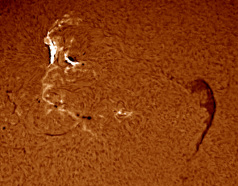| Crackling with C-class solar flares, a pair of active sunspots is emerging over the sun's northeastern limb. NASA's Solar Dynamics Observatory photographed the pair during the early hours of Jan. 15th. These sunspots have the potential for strong eruptions. Sunspot 1401 produced an M1-flare on Jan. 14th. Two days earlier, while it was still on the farside of the sun, sunspot 1402 produced a partially-eclipsed flare of uncertain magnitude that created waves of ionization in the atmosphere over Europe. NOAA forecasters estimate a 30% chance of more M-flares during the next 24 hours. |
Sunspot complex 1401-1402 erupted this morning, Jan. 16th at approximately 0400 UT, producing a C6-class solar flare (SDO movie) and a bright coronal mass ejection. SOHO recorded the expanding cloud:
| According to a forecast track prepared by analysts at the Goddard Space Weather Lab, this CME will hit Venus during the late hours of Jan. 18th. Because Venus has no global magnetic field to protect it, the impact will erode a small amount of atmosphere from the planet's cloudtops. There's no cause for concern, however, because Venus's massive atmosphere will scarcely notice the loss. The same analysis shows that the CME might deliver a glancing blow to Earth's magnetic field around 1200 UT on Jan. 19th. The impact could cause geomagnetic activity and auroras around the Arctic Circle. |
A phalanx of sunspots is turning toward Earth. The large one, AR1401, with AR1402 and AR1405 close by, has a "beta-gamma" magnetic field that harbors energy for M-class solar flares. At the moment it is unleashing one such flare every day, such as this flash recorded during the late hours of Jan. 19th. Eruptions from AR1401/1402/1405 will become increasingly geoeffective in the days ahead as the sun's rotation aligns the active region with our planet.

The active sunspot region AR1401/1402/1405 erupted today, Jan. 19th, between 15:15 and 16:30 UT. The long-duration blast produced an M3-class solar flare and a CME that appears to be heading toward Earth.
NASA's twin STEREO spacecraft recorded an impressive CME emerging from the blast site. Analysts at the Goddard Space Weather Lab confirm that the CME is heading for Earth, and they say strong geomagnetic storms are possible (although not guaranteed) when the cloud arrives this weekend. Their animated forecast track predicts an impact on Jan. 21st at 22:30 UT (+/- 7 hrs).
http://spaceweather.com/


 RSS Feed
RSS Feed